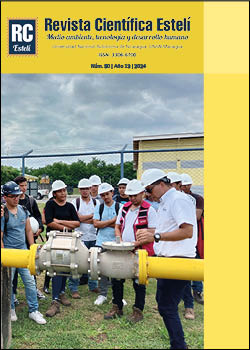Impact of social phobia in students from 15 to 18 years old of the Colegio Cristiano Gamaliel of Managua
DOI:
https://doi.org/10.5377/esteli.v13i51.19003Keywords:
Social phobia, academic achievement, effective communication, student quality of lifeAbstract
The article investigated the prevalence and effects of social phobia among students from 15 to 18 years old of the Colegio Cristiano Gamaliel of Managua during the period from September to November 2023. The general objective of the study was to identify the impact of social phobia in the students of the Colegio Cristiano Gamaliel. The research had a fundamentally quantitative, descriptive approach, with a non-experimental design that included the application of questionnaires and observations to collect data from a random sample of 88 students of the school. The results show a high prevalence of social phobia among the students, particularly fear of public speaking, which negatively affects their performance in academic and social situations. Females and students of lower socioeconomic status are more likely to experience social phobia. The study underscores the need to implement interventions to help students overcome social phobia and improve their academic and social functioning. In addition, the results are consistent with previous research on the impact of social phobia on students’ academic and social outcomes.
Downloads
References
Alonso, J., Angermeyer, M. C., Bernert, S., Bruffaerts, R., Brugha, T. S., Bryson, H., De Girolamo, G., De Graaf, R., Demyttenaere, K.,…Vollebergh, W. A. M. (2004). Prevalence of mental disorders in Europe: results from the European Study of the Epidemiology of Mental Disorders (ESEMeD) project. Acta Psychiatrica Scandinavica, 109(s420), 21-27. https://doi.org/10.1111/j.1600-0047.2004.00327.x
American Psychiatric Association. (2013). Diagnostic and statistical manual of mental disorders (5th ed.).
Amador, V. I., y Amaya, J. A. (2017). Prevalencia y factores asociados a signos y síntomas del Trastorno de Ansiedad Generalizada y Trastorno de Pánico en estudiantes de Medicina de II a VI año de UNAN-León de Abril-Junio del año 2016. [Tesis, Universidad Nacional Autónoma de Nicaragua, León.]. http://riul.unanleon.edu.ni:8080/jspui/bitstream/123456789/6993/1/241197.pdf
Boukhechba, M., Chow, P., Fua, K., Teachman, B. A., & Barnes, L. E. (2018). Predicting Social Anxiety From Global Positioning System Traces of College Students: Feasibility Study. JMIR Mental Health, 5(3), e10101. https://doi.org/10.2196/10101
Clark, DM y Wells, A. (1995). Un modelo cognitivo de la fobia social. En RG Heimberg, MR Liebowitz, DA Hope y FR Schneier, RG Heimberg, MR Liebowitz, DA Hope y FR Schneier (Eds.), Diagnóstico, evaluación y tratamiento de la fobia social (pp.69-93). New York Guilford Press.
González, V. M. (2020). Prevalencia de estrés y su relación con el rendimiento académico en estudiantes de VI año de la Carrera de Medicina de la Universidad Nacional Autónoma de Nicaragua, León 2020. [Monografía de tesis, Universidad Nacional Autónoma de Nicaragua, León.]. http://riul.unanleon.edu.ni:8080/jspui/bitstream/123456789/9230/1/247412.pdf
Hajure, M., & Abdu, Z. (2020). Social Phobia and Its Impact on Quality of Life Among Regular Undergraduate Students of Mettu University, Mettu, Ethiopia. Adolescent Health, Medicine and Therapeutics, 11, 79-87. https://doi.org/10.2147/AHMT.S254002
Hakami, R. M., Mahfouz, M. S., Adawi, A. M., Mahha, A. J., Athathi, A. J., Daghreeri, H. H., Najmi, H. H., & Areeshi, N. A. (2018). Social anxiety disorder and its impact in undergraduate students at Jazan University, Saudi Arabia. Mental Illness, 9(2), 7274. https://doi.org/10.4081/mi.2017.7274
Heimberg, R. G., Hofmann, S. G., Liebowitz, M. R., Schneier, F. R., Smits, J. A. J., Stein, M. B., Hinton, D. E., & Craske, M. G. (2014). Social anxiety disorder in DSM-5. Depression and Anxiety, 31(6), 472-479. https://doi.org/10.1002/da.22231
Hernández, L. M.-C. (2021, mayo 13). El impacto de la fobia social en el rendimiento educativo. https://psicologiaymente.com/clinica/impacto-fobia-social-rendimiento-educativo
Hernández Sampieri, R., Fernández Collado, C., y Baptista Lucio, P. (2014). Metodología de la investigación. (6a. ed.). McGraw-Hill.
Hernández Sampieri, R., Fernández Collado, C., & Baptista Lucio, P. (2010). Metodología de la investigación. (5ª. Ed.). Mc Graw Hill.. https://www.academia.edu/20792455/Metodolog%C3%ADa_de_la_Investigaci%C3%B3n_5ta_edici%C3%B3n_Roberto_Hern%C3%A1ndez_Sampieri
Hernández Sampieri, R., Fernández-Collado, C., y Baptista Lucio, P. (2006). Metodología de la investigación. (4ta. ed.). México Trillas. Retrieved from http://www.univo.edu.sv:8081/tesis/020090/020090_Cap1.pd
Jadue J, G. (2001). Algunos efectos de la ansiedad en el rendimiento escolar. Estudios pedagógicos (Valdivia), 27, 111-118. https://doi.org/10.4067/S0718-07052001000100008
Martínez-Casasola, L. (2021). El impacto de la fobia social en el rendimiento educativo. Psicología y Mente. Recuperado de https://psicologiaymente.com/clinica/impacto-fobia-social-rendimiento-educativo.
Medina, E. J., Montoya, W. A., & Toruño, J. J. (2015). Incidencia de la ansiedad en el rendimiento académico en estudiantes del tercer nivel, Escuela Preparatoria, Facultad de Educación e Idiomas, Unan-Managua, período Septiembre-Diciembre 2015. [Trabajo Monográfico, Universidad Nacional Autonoma de Nicaragua UNAN-MANAGUA]. https://repositorio.unan.edu.ni/id/eprint/10426/1/9133.pdf
Piura López, J. (2006). Metodología de la investigación científica: un enfoque integrador (1.a ed.). PAVSA.
Rao, P. A., Beidel, D. C., Turner, S. M., Ammerman, R. T., Crosby, L. E., & Sallee, F. R. (2007). Social anxiety disorder in childhood and adolescence: Descriptive psychopathology. Behaviour Research and Therapy, 45(6), 1181-1191. https://doi.org/10.1016/j.brat.2006.07.015
Sánchez-Pedreño (s.f) Síntomas, diagnóstico y tratamiento. https://www.cun.es. Recuperado 5 de marzo de 2024, de https://www.cun.es/enfermedades-tratamientos/enfermedades/fobias
Stein, M. B., & Stein, D. J. (2008). Social anxiety disorder. Lancet (London, England), 371(9618), 1115-1125. https://doi.org/10.1016/S0140-6736(08)60488-2
Tamayo y Tamayo. (2007). El Proceso de la Investigación Científica. (4ta ed.) Editorial Limusa.
Téllez Solís, M. G., & Traña Aguirre, I. A. (2017). Los niveles de ansiedad que inciden en el rendimiento académico de quinto año, entre las edades de 15-19 años, del Instituto Ramón Matus Acevedo, del turno matutino, en el segundo semestre del 2017. [Seminario de Graduación, Universidad Nacional Autónoma de Nicaragua FAREM Carazo]. https://repositorio.unan.edu.ni/id/eprint/16806/1/T%C3%A9l%202017.pdf
Tillfors, M., & Furmark, T. (2006). Social phobia in Swedish university students: prevalence, subgroups and avoidant behavior. Social Psychiatry And Psychiatric Epidemiology, 42(1), 79-86. https://doi.org/10.1007/s00127-006-0143-2
Useche, M., Artigas, W., Queipo, B., y Perozo, É. (2019). Técnicas e instrumentos de recolección de datos cuali-cuantitativos (1 ed.). Colombia: Editorial Gente Nueva. https://www.researchgate.net/publication/344256464_Tecnicas_e_instrumentos_de_recoleccion_de_datos_Cuali-Cuantitativos
World Health Organization: WHO. (2023, 27 septiembre). Trastornos de ansiedad. https://www.who.int/es/news-room/fact-sheets/detail/anxiety-disorders
Downloads
Published
Issue
Section
License
Copyright (c) 2024 Revista Científica Estelí

This work is licensed under a Creative Commons Attribution-NonCommercial-ShareAlike 4.0 International License.

